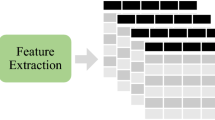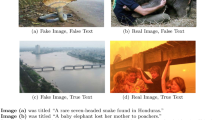Abstract
This paper analyzes a large number of logo images from the LLD-logo dataset, by recent deep learning-based techniques, to understand not only design trends of logo images and but also the correlation to their owner company. Especially, we focus on three correlations between logo images and their text areas, between the text areas and the number of followers on Twitter, and between the logo images and the number of followers. Various findings include the weak positive correlation between the text area ratio and the number of followers of the company. In addition, deep regression and deep ranking methods can catch correlations between the logo images and the number of followers.
Access this chapter
Tax calculation will be finalised at checkout
Purchases are for personal use only
Similar content being viewed by others
Notes
- 1.
There are several variations in the logo type classification. For example, in [1], three types are called “text-based logo”, “iconic or symbolic logo”, and “mixed logo”, respectively.
- 2.
Not available now. According to [15], it contained 123 logo images.
- 3.
The number of followers is provided in the file LLD-logo.hdf5, which is provided with LLD-logo image data. Precisely, the resource of meta_data/twitter/user_objects in this hdf5 file contains the followers_count data, which corresponds to the number of followers.
- 4.
For the logarithmic plot, we exclude the companies with zero follower. The number of such companies is around 1,000 and thus no serious effect in our discussion.
- 5.
As we will see later, the text area ratio sometimes exceeds 100%. There are several reasons behind it; one major reason is the ambiguity of the whole logo’s bounding box and the individual text areas’ bounding boxes. If the latter slightly becomes the former, the ratio exceeds 100%. Some elaborated post-processing might reduce those cases; however, they do not significantly affect our median-based analysis.
- 6.
Recall that each distribution is normalized. As noted before, logotypes are just 4%, whereas logo symbols are 26%. Thus, as the absolute numbers, the famous companies use more logo symbols than logotypes.
References
Adîr, G., Adîr, V., Pascu, N.E.: Logo design and the corporate identity. Procedia. Soc. Behav. Sci. 51, 650–654 (2012)
Aljalbout, E., Golkov, V., Siddiqui, Y., Strobel, M., Cremers, D.: Clustering with deep learning: taxonomy and new methods. arXiv preprint arXiv:1801.07648 (2018)
Ardon, S., et al.: Spatio-temporal analysis of topic popularity in twitter. arXiv preprint arXiv:1111.2904 (2011)
Baek, Y., Lee, B., Han, D., Yun, S., Lee, H.: Character region awareness for text detection. In: CVPR (2019)
Bakshy, E., Hofman, J.M., Mason, W.A., Watts, D.J.: Everyone’s an influencer: quantifying influence on twitter. In: ACM WSDM (2011)
Burges, C., et al.: Learning to rank using gradient descent. In: ICML (2005)
Caron, M., Bojanowski, P., Joulin, A., Douze, M.: Deep clustering for unsupervised learning of visual features. In: Ferrari, V., Hebert, M., Sminchisescu, C., Weiss, Y. (eds.) Computer Vision – ECCV 2018. LNCS, vol. 11218, pp. 139–156. Springer, Cham (2018). https://doi.org/10.1007/978-3-030-01264-9_9
Guo, J., et al.: A deep look into neural ranking models for information retrieval. Inf. Proc. Manag. 57(6), 102067 (2020)
Karamatsu, T., Suehiro, D., Uchida, S.: Logo design analysis by ranking. In: ICDAR (2019)
Lerman, K., Ghosh, R., Surachawala, T.: Social contagion: an empirical study of information spread on digg and twitter follower graphs. arXiv preprint arXiv:1202.3162 (2012)
Luffarelli, J., Mukesh, M., Mahmood, A.: Let the logo do the talking: the influence of logo descriptiveness on brand equity. J. Marketing Res. 56(5), 862–878 (2019)
Luffarelli, J., Stamatogiannakis, A., Yang, H.: The visual asymmetry effect: An interplay of logo design and brand personality on brand equity. J. Marketing Res. 56(1), 89–103 (2019)
Ma, N., Volkov, A., Livshits, A., Pietrusinski, P., Hu, H., Bolin, M.: An universal image attractiveness ranking framework. In: WACV (2019)
Min, E., Guo, X., Liu, Q., Zhang, G., Cui, J., Long, J.: A survey of clustering with deep learning: from the perspective of network architecture. IEEE Access 6, 39501–39514 (2018)
Neumann, J., Samet, H., Soffer, A.: Integration of local and global shape analysis for logo classification. Patt. Recog. Lett. 23(12), 1449–1457 (2002)
Sage, A., Agustsson, E., Timofte, R., Van Gool, L.: Logo synthesis and manipulation with clustered generative adversarial networks. In: CVPR (2018)
Stringhini, G., et al.: Follow the green: growth and dynamics in twitter follower markets. In: Internet Measurement Conference (2013)
Su, H., Gong, S., Zhu, X.: WebLogo-2M: scalable logo detection by deep learning from the web. In: ICCVW (2017)
Sundar, A., Noseworthy, T.J.: Place the logo high or low? Using conceptual metaphors of power in packaging design. J. Marketing 78(5), 138–151 (2014)
Tang, H., Chen, K., Jia, K.: Unsupervised domain adaptation via structurally regularized deep clustering. In: CVPR (2020)
Wang, J., et al.: Logo-2k+: a large-scale logo dataset for scalable logo classification. In: AAAI (2020)
Zhan, X., Xie, J., Liu, Z., Ong, Y.S., Loy, C.C.: Online deep clustering for unsupervised representation learning. In: CVPR (2020)
Zhao, W.: A brief analysis on the new trend of logo design in the digital information era. In: ESSAEME (2017)
Acknowledgment
This work was supported by JSPS KAKENHI Grant Number JP17H06100.
Author information
Authors and Affiliations
Corresponding author
Editor information
Editors and Affiliations
Rights and permissions
Copyright information
© 2021 Springer Nature Switzerland AG
About this paper
Cite this paper
Nishi, S., Kadota, T., Uchida, S. (2021). Famous Companies Use More Letters in Logo: A Large-Scale Analysis of Text Area in Logo. In: Barney Smith, E.H., Pal, U. (eds) Document Analysis and Recognition – ICDAR 2021 Workshops. ICDAR 2021. Lecture Notes in Computer Science(), vol 12916. Springer, Cham. https://doi.org/10.1007/978-3-030-86198-8_8
Download citation
DOI: https://doi.org/10.1007/978-3-030-86198-8_8
Published:
Publisher Name: Springer, Cham
Print ISBN: 978-3-030-86197-1
Online ISBN: 978-3-030-86198-8
eBook Packages: Computer ScienceComputer Science (R0)





